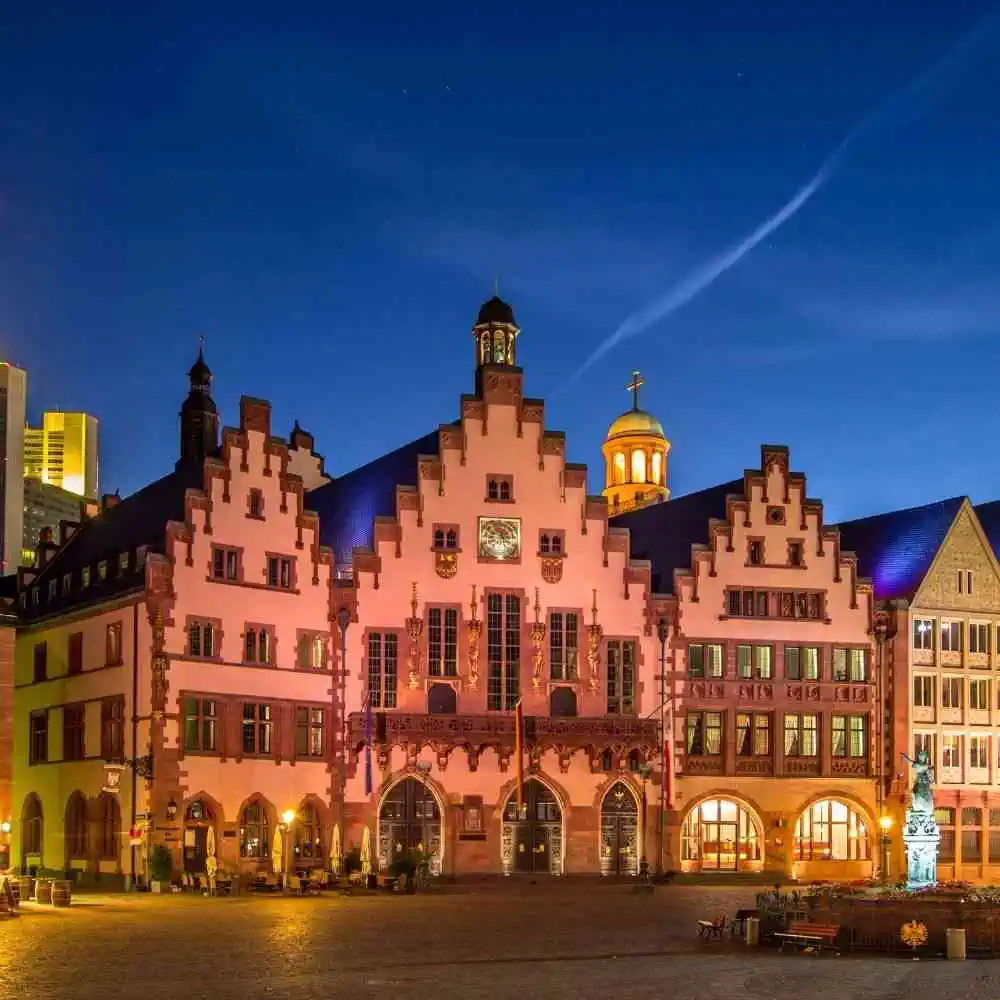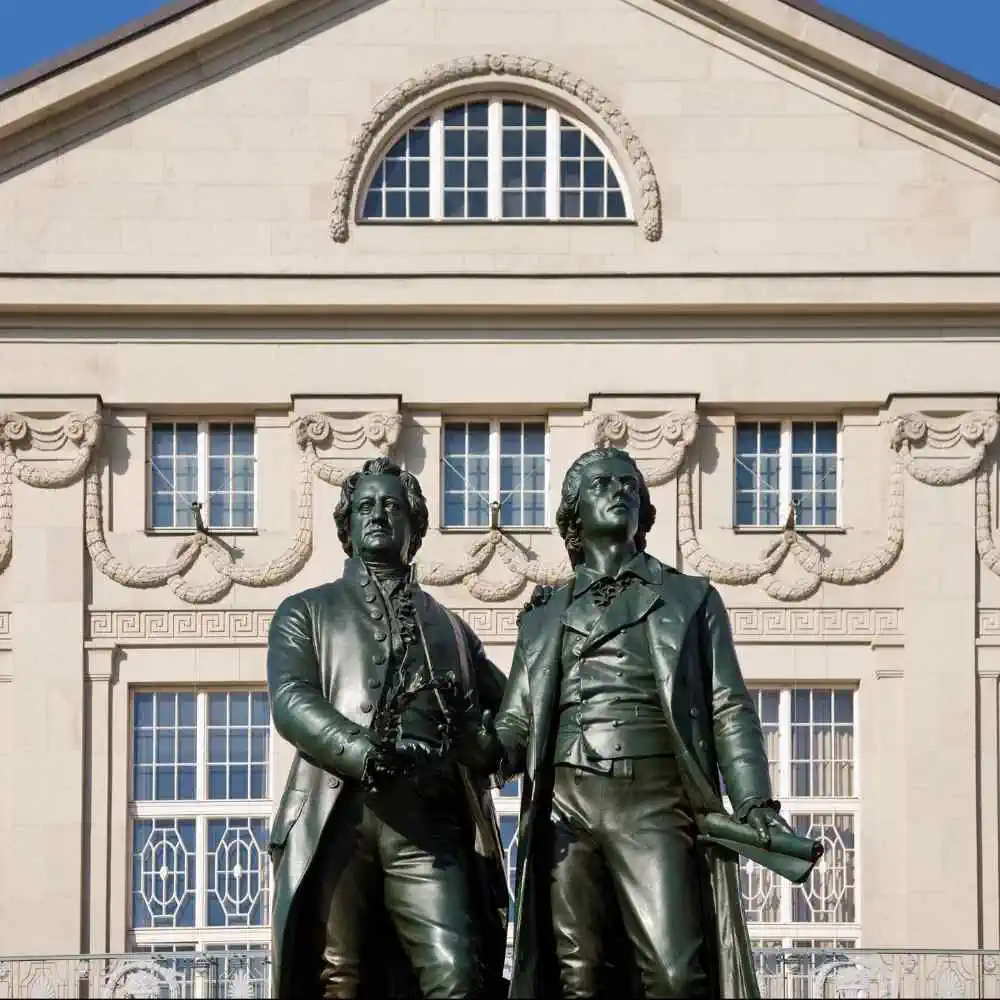Você partirá de Estação Central de Frankfurt (Main), localizado bem no centro da cidade de Frankfurt, e desfrutará da bela paisagem da viagem enquanto chega em Weimar, também localizada no coração de Weimar.
Trens de Frankfurt para Weimarde € 45.00
Trens de Frankfurt para Weimar
Viajando de trem: Frankfurt - Weimar
Exploring the Train Journey from Frankfurt-am-Main to Weimar!
The entire trip is about 270 kilometers (168 miles) long, and the fastest route usually takes less than 3 hours. Along the way, you’ll pass through some of Germany’s most important cities and picturesque towns.
The journey starts at Frankfurt Hauptbahnhof, the largest financial center in Germany and a major cultural hub. From the station, the first stop is the historic city of Fulda, home to stunning old churches and impressive palaces. Then, the train speeds past the ancient towns of Gießen and Marburg to Erfurt, a beautiful city with its own fascinating history.
Finally, the train arrives in Weimar, the birthplace of Germany’s world-famous literary movement. As you travel through the stunning countryside, explore the city’s famous gardens and museums, and be sure to take a trip to the stunning Goethe National Monument.
Take the train from Frankfurt-am-Main to Weimar and experience a journey full of culture and beauty!

Detalhes da viagem
How long does the train from Frankfurt to Weimar take?
The fastest train from Frankfurt to Weimar takes approximately, 3h although some high speed trains can reduce the total travel timeHow much does the train cost from Frankfurt to Weimar?
The cost of a train ticket from Frankfurt to Weimar varies depending on the type of ticket, class, fare and the route. Generally, a one-way ticket starts from € 45.00. It is recommended to search the prices to get the best deals.How much does the Frankfurt to Weimar?
There are direct trains from Frankfurt to Frankfurt. What is the distance between Frankfurt and Weimar by train? The distance between Frankfurt and Weimar by train is 270km (168 Mi) Which is the main train station for Frankfurt Frankfurt main station is Frankfurt Main Hbf located right in the heart of the city of Frankfurt Which is the main train station for Weimar Weimar main station is Weimar located right in the center of the city of WeimarFrankfurt: Locais para ver
A cidade de Frankfurt, na Alemanha, é um lugar fascinante que mistura o antigo e o moderno de maneira única. Com sua rica história e arquitetura impressionante, Frankfurt oferece aos visitantes um vislumbre do passado, enquanto ainda respira modernidade. Mas o que torna Frankfurt verdadeiramente especial? Vamos descobrir juntos enquanto exploramos os lugares mais icônicos que você simplesmente não pode perder.
Römerberg: O coração histórico de Frankfurt, conhecido por suas encantadoras construções em estilo enxaimel. Não deixe de visitar a Prefeitura, conhecida como Römer. Este lugar é uma parada obrigatória para entender a alma da cidade.
Catedral de São Bartolomeu (Dom St. Bartholomäus): Uma magnífica construção gótica que tem sido um símbolo de poder e fé ao longo dos séculos. Sua torre oferece uma vista incrível da cidade.
Museumsufer: Uma orla repleta de museus de todos os tipos, desde arte e cultura até história natural. É o lugar perfeito para mergulhar na rica tradição cultural de Frankfurt.
Main Tower: Para os amantes de vistas panorâmicas, subir neste arranha-céu oferece uma das melhores perspectivas da cidade. Ver Frankfurt de cima é uma experiência imperdível.
Palmengarten: O jardim botânico de Frankfurt é um oásis de tranquilidade e beleza natural, ideal para uma pausa relaxante da agitação da cidade.
Goethe Haus: A casa onde nasceu o famoso escritor alemão Johann Wolfgang von Goethe é hoje um museu dedicado à sua vida e obra. Uma visita inspiradora para amantes da literatura.
Alte Oper: A antiga ópera, reconstruída após ser destruída na Segunda Guerra Mundial, é agora uma concert hall que recebe performances de todo o mundo. Confira a programação para uma noite inesquecível.
Explorar Frankfurt é mergulhar em uma cidade que não só preserva suas raízes históricas mas também abraça o futuro com entusiasmo. Entre caminhadas pelas ruas de paralelepípedos do Römerberg e a admiração pelas linhas modernas do Main Tower, Frankfurt revela-se uma cidade de contrastes apaixonantes. E quando a fome bater, não deixe de provar as tradicionais salsichas alemãs em um dos muitos restaurantes locais, acompanhadas, é claro, de uma refrescante cidra de maçã. Viajar por Frankfurt é uma experiência que combina cultura, história e modernidade de maneira singular, deixando na memória momentos que certamente vão querer ser revisitados.

Weimar: Locais para ver
Weimar is a city of culture and history located in the German state of Thuringia. With its beautiful architecture, parks and gardens, and significant contributions to the nation’s cultural and political landscape, Weimar is a great destination for any traveler looking for something different and interesting. Here’s a list of the seven must-visit historical and architectural sites, including what to do and where to eat.
Duchess Anna Amalia Library: This former library of the duchy has been open to the public since 1919, and contains many rare books and manuscripts, including several works by Goethe, Bach, Beethoven, and Schiller. It’s located in the center of Weimar, close to tourist attractions like Goethe’s House, so it’s easy to access on foot. Visitors are welcome to browse the shelves, and the entrance fee is €3.
St. Peter and Paul Church: This 13th-century church is the oldest and most important example of Weimar Gothic architecture. It is located on Schlossplatz, in the Old Town area of the city, and is open to visitors from 9am to 6pm. Entrance is free, and the church also offers tours and organ concerts throughout the year.
Belvedere Castle: This castle is home to the Weimar National Art Gallery. With a stunning view of Weimar from its terrace, the castle includes a variety of artworks from the Middle Ages to modern times. The entrance fee is €8, and the castle is open from 10am to 5pm.
Goethe's House: This was the home of the great poet Johann Wolfgang Goethe from 1775 until his death in 1832. The house is in the City Center, and is open from 10am to 5pm. Here, visitors can explore a variety of artifacts and artworks by Goethe and his contemporaries. Entrance is €5.
City Park: This popular park is located in the heart of the city and is an idyllic spot to relax and soak up the atmosphere. The park is open all year round, and entrance is free.
Weimar Market Square: This market square is the liveliest place in Weimar, filled with cafés, bars, shops, and restaurants. Visitors of all ages can enjoy the lively atmosphere here, and the market runs from 9am to 6pm.
Weimar cuisine: No trip to Weimar would be complete without trying the local food. The city is renowned for its hearty, traditional dishes, with the Weimar dumpling being a favorite.
There are so many places to explore and things to do in Weimar. Whether you’re looking for culture, history, or great food, the city has something for everyone. So why not experience all that Weimar has to offer?

Frankfurt: Principais estações de trem
A estação ferroviária principal de Frankfurt, conhecida como Frankfurt Hauptbahnhof, é um dos principais pontos de conexão para viajantes em Alemanha. Além dela, Frankfurt conta com outras estações relevantes como Frankfurt Süd e Frankfurt Flughafen, que servem tanto a locais quanto a destinos internacionais. A Hauptbahnhof destaca-se por seu papel crucial na rede ferroviária, facilitando o acesso a diversas cidades europeias e locais de interesse em Frankfurt.
O endereço da estação ferroviária principal de Frankfurt é Am Hauptbahnhof, situada no coração da cidade, o que facilita a locomoção para diferentes áreas. O horário de funcionamento é amplo, adaptando-se à agenda de qualquer viajante. Para aqueles com muita bagagem, a estação oferece serviços de consignação de bagagens, garantindo segurança e conveniência enquanto explora os encantos de Frankfurt. Essas facilidades tornam a Hauptbahnhof não apenas um ponto de trânsito, mas também uma porta de entrada para uma experiência inesquecível na Alemanha.
- Estação Central de Frankfurt (Main)
- Frankfurt (M) Flughafen Fernbf
- Frankfurt-Eschersheim
- Frankfurt-Griesheim
- Frankfurt-Rödelheim
Weimar: Principais estações de trem
Weimar, Germany is home to the main train station, Weimar Hauptbahnhof. It is the city's chief transportation hub, offering a variety of services, including connections to other important train stations in Germany such as Leipzig, Berlin, Erfurt and more. Intercity buses also arrive and depart from the station.
The station is located at Karl-Liebknecht-Straße 9, 99423 Weimar. Opening hours are 5.00 am – 11.00 pm and customers can reach the station’s info line at +49 (0) 3643 860. It offers a wide range of services, such as luggage storage, postal services, bike rentals and more.
- Weimar
Frankfurt - Weimar: Como conseguir as melhores ofertas
Reserve com Antecedência:
Assim como nas passagens aéreas, os preços dos bilhetes de trem tendem a aumentar à medida que a data de partida se aproxima. Reservar com semanas ou até meses de antecedência pode economizar uma quantia significativa.
Viaje Fora do Horário de Pico:
Evite viajar em horários de pico, como nas manhãs e noites de dias úteis. Opte por viagens ao meio-dia, no final da noite ou durante a semana, quando há menos demanda.
Considere trens mais lentos ou rotas não diretas:
Os trens expressos ou de alta velocidade podem economizar tempo, mas geralmente são mais caros. Optar por serviços regionais ou mais lentos pode reduzir sua tarifa.
Procure por Ofertas Especiais e Promoções:
Os operadores de trens ocasionalmente têm promoções ou ofertas especiais, especialmente durante a temporada de baixa demanda. Vale a pena se inscrever para receber newsletters. Além disso, às vezes existem descontos para grupos ou para bilhetes de ida e volta, então considere essas opções se elas se encaixarem em seus planos de viagem.
Tudo que você precisa saber sobre
Precisa de nossa ajuda?
Pagamento seguro garantido
Certificados


